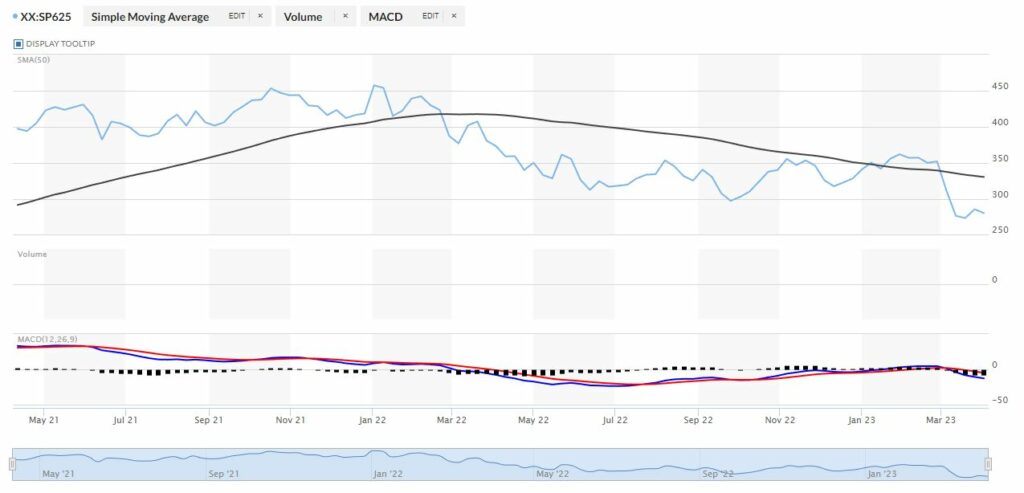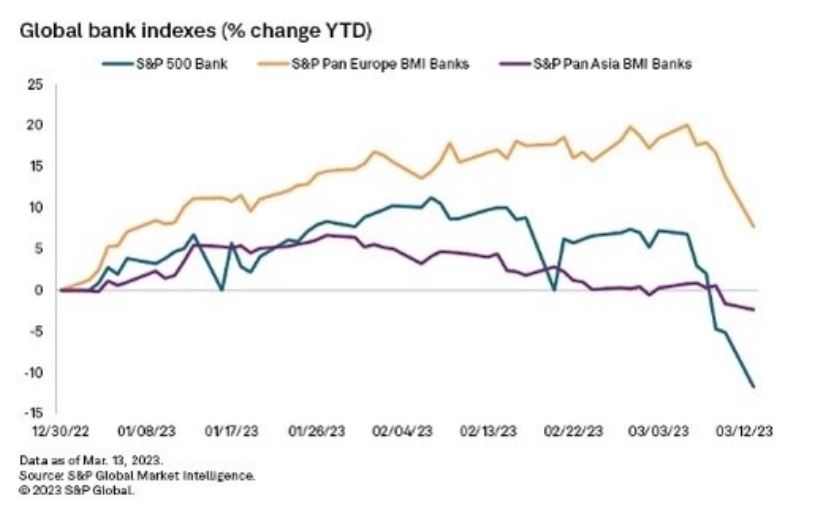Key Takeaways:
- Deposit outflow from US banks persists
- Will the damaged Banking Industry Group Index rebound?
- The banks work on wooing potential clients, but JPMorgan sees “more trouble ahead.”

YEREVAN (CoinChapter.com) – The US banking system saw record outflows, almost $1 trillion in the previous year, since the Fed started implementing its quantitative tightening policies in March 2022.
Deposit outflows damage the US Banking Industry Group Index.
Consecutive failures of Silvergate, Silicon Valley Bank, Credit Suisse, and other banking institutions also spooked depositors in March 2023, further fuelling the massive exodus.

In tune with the deposit outflows, the S&P 500 Banks Industry Group Index (SP625), tracking the performance of the US banking industry, fell 34% in the previous year, with a sharp 17% drop since the Silicon Valley Bank implosion.

The European bank indexes dropped, while their Asian counterparts showed more resilience.

On a more detailed time frame, the deposit outflow partially stabilized in the week ending March 29. Federal Reserve data released on April 7 showed deposits at all commercial banks rose to $17.35 trillion, on a nonseasonally adjusted basis, from a downwardly revised $17.31 trillion a week earlier.
Also read: Bitcoin Price Prints Bullish Technical Pattern, Why Close Above $28.5K Is Critical.
Deposits rose at the largest 25 banks by assets and small and mid-sized banks. Notably, smaller banks were hit hardest by the back-to-back failures, with some depositors shifting cash to larger institutions on concern that any funds over the $250,000 per depositor federal insurance limit might be at risk. However, is the mild stabilization indicative of a bias change?
The depositor trust is not back yet.
Banking largely relies on trust between the depositors and the institution. When confidence is broken for any reason, the mistrust quickly spreads, leading to “nerves and jitters,” even if unfounded.
The en-masse depositor exodus shows low confidence in the banking system and expectations of more turbulence. Jamie Dimon, the longtime JPMorgan Chase CEO, has a similar outlook.
He noted that the stress on regional banks had led investors and analysts to suggest that the “too big to fail” institutions would benefit from the crisis. Instead, JPMorgan wants to “strengthen the smaller banks” to benefit the whole financial system.
“Any crisis that damages Americans’ trust in their banks damages all banks – a fact that was known even before this crisis. While it is true that this bank crisis ‘benefited’ larger banks due to the inflow of deposits they received from smaller institutions, the notion that this meltdown was good for them in any way is absurd.”
he wrote in an annual letter to shareholders
Dimon also noted that “the current crisis is not yet over, and even when it is behind us, there will be repercussions from it for years to come.”
Meanwhile, US banks are taking steps towards wooing their depositors back.
Banks strive to meet client needs.
Consumers have clamored banks to pay more for deposits for months since the Fed implemented consecutive interest rate hikes. And, given the current crisis, lenders are prepared to rethink their offers to keep customers’ cash parked in their accounts longer.
For example, Capital One Financial Corp is advertising a $100 bonus for opening a new savings account and keeping more than $10,000 in it for 90 days.
The offer also includes a bonus of $1,000 for large deposits of over $100,000. Similarly, Discover Financial Services and LendingClub offer perks to clients, which were in effect before the bank runs began.
Also read: Donald Trump Calls Joe Biden "Biggest Moron" as Afghanistan Withdrawal Report Triggers Blame Game.
According to emails to customers after March 10, Citizens Financial Group offers a $25 bonus for customers who put in $100 monthly for three months and maintain a minimum balance.
Andrew Davidson, chief insights officer at Mintel, a market intelligence agency, commented that the overall drop in deposits triggered “intense competition” between banks to woo potential depositors and keep the existing ones.
“As rates have risen, high-yield savings accounts have become fashionable once again, with some banks competing aggressively to stay at the top of the rate tables that consumers rely on for comparison purposes.”
said the expert.
Meanwhile, the Fed’s latest decision to implement quarter-point interest rate hikes instead of half-point might indicate the upcoming end of quantitative tightening policies. In that case, the pressure on small banking institutions will likely ease as they see growing depositor confidence.


